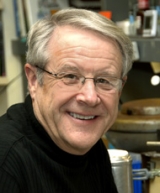Douglas D. Randall

Professor Emeritus
Department of Biochemisty
E-mail: randalld at missouri dot edu
Office address: 223 Schweitzer Hall
Office phone: 573-882-4847
Plants, like animals, must balance their metabolism to meet various needs. They have the additional advantage of being able to capture energy from sunlight, use it during the day to feed themselves and then live off stored foodstuffs at night. These processes must be carefully regulated and controlled in order for the plant to survive and grow. Our research team focuses primarily on regulatory mechanisms used by plant to control metabolic events. Overall, this process is referred to as signal transduction.
For example, plants conserve resources and energy by controlling the carbon metabolism in the mitochondria during photosynthesis and photorespiration by regulating the activity of the pyruvate dehydrogenase complex (PDC) which provides input to energy metabolism, oil synthesis and amino acid metabolism. Regulation is achieved, in part, through reversible phosphorylation of PDC by a unique protein kinase and a protein phosphatase which together provide a metabolic "on and off" switch for PDC. The unique protein kinase that phosphorylates PDC is member of a novel group of protein kinases that act on large numbers of plant proteins, few of which have been identified to date. Our team is also involved in a multi-institutional functional genomics project on plant protein kinases and phosphatases and their target proteins. We are currently involved in mutagenesis experiments with the PDC kinase in order to understand its mechanism and specificity. Investigations on PDC include engineering changes in specificity, and studies on the assembly of the three primary components that form PDC. The complex contains about 200 proteins that associate in a specific ways.
In contrast to animals, plants are unique in that they also have a second form of PDC in the plastids. Our team is investigates this multienzyme complex and its role in oil and isoprenoid synthesis. The plastid PDC is not controlled by reversible phosphorylation and its regulation as well as its composition is unique to its location in the plastids. Establishing how the two PDCs are regulated and their specific roles metabolism will help us understand how and why some plants store oils instead of starches. Our understanding of these two complexes is being used to molecularly engineer hybrid complexes that should be capable of enhancing the production of biodegradable plastics in plants.
Our research is building the knowledge base that is essential to understand how plants respond to their needs and their environment, and what types of regulatory mechanisms they use to achieve certain goals or functions within different subcellular locations. Just as importantly, the work is building the knowledge base required to develop more valuable plants for the use of mankind. Long term targets include altering oil composition of oilseed crops, sweeter vegetables, and more stress-resistant plants.
Our research team has several on campus interactions with other research teams, for example, Jan Miernyk has been colleague on all PDC work for many years. Our research team is one of several on campus, including John Walker's, Shuqun Zhang's, Jay Thelen's, and Scott Peck's research teams that are part of a multi-institutional functional genomics and proteomics effort for examining plant proteins kinases and phosphatases. Genes for protein kinases may be as much as 4-5% of the plant genome. Our laboratory is a central resource laboratory to the Interdisciplinary Plant Group members seeking assistance with protein purification and enzymology.
Huang Y, Houston NL, Tovar-Mendez A, Stevenson SE, Miernyk JA, Randall DD, Thelen JJ. A quantitative mass spectrometry-based approach for identifying protein kinase clients and quantifying kinase activity. Analytical Biochemistry 2010;402(1):69-76.
Miernyk JA, Szurmak B, Tovar-Mendez A, Randall DD, Muszynska G. Is there a signal transduction pathway that links events at the plasma membrane to the phosphorylation state of the mitochondrial pyruvate dehydrogenase complex? Physiologia Plantarum 2007;129(1):104-113.
Tovar-Mendez A, Hirani TA, Miernyk JA, Randall DD. Analysis of the catalytic mechanism of pyruvate dehydrogenase kinase. Archives of Biochemistry and Biophysics 2005;434(1 SPEC. ISS.):159-168.
Tovar-Mendez A, Miernyk JA, Randall DD. Regulation of pyruvate dehydrogenase complex activity in plant cells. European Journal of Biochemistry 2003;270(6):1043-1049.
Szurmak B, Strokovskaya L, Mooney BP, Randall DD, Miernyk JA. Expression and assembly of Arabidopsis thaliana pyruvate dehydrogenase in insect cell cytoplasm. Protein Expression and Purification 2003;28(2):357-361.
Tovar-Mendez A, Miernyk JA, Randall DD. Histidine mutagenesis of Arabidopsis thaliana pyruvate dehydrogenase kinase. European Journal of Biochemistry 2002;269(10): 2601-2606.
- Plastics Plant (Spr 2009)
- 'Green' plastics could help reduce carbon footprint (Feb 2009)
- Researcher nominated and confirmed to second National Science Board term (Feb 2008)
- Fellow, American Association for the Advancement of Science (AAAS) (2009)
- Fellow, American Society of Plant Biologists (2007)
- Thomas Jefferson Award, University of Missouri (2005)
- National Science Board Member ’02-08. Presidential appointment (2002)
- Distinguished Alumni Award, South Dakota State University (2000)
- Chair, Board of Trustees, American Society of Plant Physiologists (1996-1999)
- Gamma Sigma Delta, Research Excellence (1995)
- William H. Byler Distinguished Professor Award (1993)
- Secretary, American Society of Plant Physiologists (1991-1993)
- Faculty-Alumni Award, University of Missouri (1991)
- Gold Chalk Teaching Award, Biological Sciences Division, University of Missouri (1991)
- Robert and Katherine Burris Lecturer, South Dakota State University (1990)
- Distinguished Alumni Award-Biochemistry Department, Michigan State University (1988)
- National Science Foundation Great Barrier Reef Photorespiration Expedition (1973)